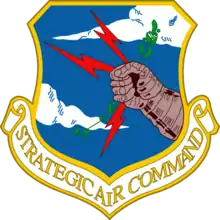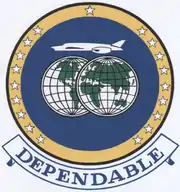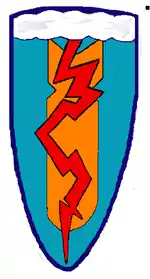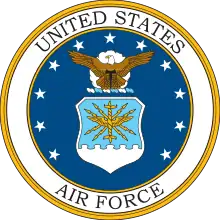919th Air Refueling Squadron
The 919th Air Refueling Squadron is an inactive United States Air Force unit. It was last assigned to the 306th Bombardment Wing, stationed at McCoy Air Force Base, Florida. It was inactivated on 30 June 1971.
919th Air Refueling Squadron
 | |
|---|---|
%252C_USA_-_Air_Force_AN1137013.jpg.webp) Boeing KC-135A Stratotanker in Strategic Air Command markings | |
| Active | 1943; 1944–1945; 1960–1971 |
| Country | |
| Branch | |
| Role | Air Refueling |
| Motto(s) | Dependable |
| Decorations | Air Force Outstanding Unit Award |
| Insignia | |
| 919th Air Refueling Squadron emblem |  |
| 619th Bombardment Squadron emblem (approved 18 August 1944)[1] |  |
The squadron was first activated as the 619th Bombardment Squadron in 1943. It was one of the four squadrons of the 477th Bombardment Group, the first (and only) bombardment group in the United States Army Air Forces to include black pilots. Members of the squadron participated in the Freeman Field Mutiny, protesting racial segregation in the military. The squadron was inactivated in 1945 when the 477th became a composite group that included one bombardment and one fighter squadron.
The 919th Air Refueling Squadron was activated as a Strategic Air Command (SAC) tanker squadron in 1960 and moved to Turner Air Force Base, Georgia as part of SAC's program to disperse its Boeing B-52 Stratofortress as a defense against a first strike by the Soviet Union. The squadron served in this capacity for eleven years during which it deployed aircraft and aircrews to Southeast Asia during the Viet Nam War.
The two squadrons were consolidated into a single unit in 1985, but the consolidated squadron has never been active.
History
World War II

The 619th Bombardment Squadron was activated in June 1943 at MacDill Field, Florida. as one of the four original squadrons of the 477th Bombardment Group, but was inactivated in August.[1][2]
The 477th group was reactivated in January 1944 at Selfridge Field, Michigan as the "first colored bombardment group in the Army Air Forces" with personnel drawn from Selfridge and from Tuskegee Army Air Field, Alabama.[3] It was the second combat group to be activated with African American personnel and would be the only African-American bombardment group.[4] The group moved to Godman Field, Kentucky, where the 619th was activated in May.[1] The unit encountered problems attributed to the lack of experienced personnel, which required even basic training in military occupational specialties to be conducted within the unit, rather than at technical training schools.[5]
Although designated a "colored" squadron, some officers, including the squadron leadership were white. The initial commander of the 477th Group enforced racial segregation on the posts where the squadron was stationed. The squadron's members were involved in the civil rights action referred to as the Freeman Field Mutiny; the "mutiny" came about when African-American aviators became outraged enough by racial segregation in the military that they resorted to mass insistence that military regulations prohibiting discrimination be enforced. The Freeman Field Mutiny was a crucial event in the African-American struggle for equal civil rights.[6]
The 619th was inactivated in June 1945 when the 477th became a composite group formed of the 99th Fighter Squadron, 617th Bombardment Squadron and 618th Bombardment Squadron[7] and Colonel Benjamin O. Davis, Jr., a black officer, assumed command of the group.[2]
Cold War
The 919th Air Refueling Squadron was activated on 15 April 1960 by Strategic Air Command (SAC) at Carswell Air Force Base, Texas[8] and assigned to the 7th Bombardment Wing[9] as one of two tanker squadrons activated that day for assignment to dispersed Boeing B-52 Stratofortress wings. The squadron was equipped with Boeing KC-135 Stratotankers. The squadron moved to Turner Air Force Base, Georgia in June and was assigned to the 4138th Strategic Wing, where half of the squadrons's aircraft were maintained on fifteen-minute alert, fully fueled and ready for combat.[10] The 919th maintained its alert commitment until it was inactivated, except for periods when the squadron was deployed.
The squadron deployed aircraft and aircrew to the Western Pacific, 1966–1967 to support SAC operations along with tactical aircraft flying combat missions over Indochina during the Vietnam War (Operation Young Tiger).[11] During September 1966, the squadron was non-operational when all its crews and aircraft were deployed to support Operation Arc Light.[12] When Turner AFB was transferred to the United States Navy in 1967[13] for re-designation as Naval Air Station Albany (Turner Field), the squadron moved to McCoy Air Force Base, Florida. In 1969 the squadron won the Saunders Trophy as the best air refueling squadron during SAC's annual Bombing and Navigation Competition.[14] The following year the squadron converted from KC-135A aircraft to KC-135Qs.[15] The squadron remained at McCoy until it was inactivated in 1971 and its equipment and personnel transferred to the 306th Air Refueling Squadron.
The 919th Air Refueling Squadron was consolidated with the 619th Bombardment Squadron in 1985 but the consolidated squadron has not been active.[16]
Lineage
|
619th Bombardment Squadron
|
919th Air Refueling Squadron
|
Assignments
- 477th Bombardment Group: 1 June 1943 – 25 August 1943
- 477th Bombardment Group: 27 May 1944 – 22 June 1945[17]
- 7th Bombardment Wing: 15 April 1960[9]
- 4138th Strategic Wing: 15 June 1960[10]
- 484th Bombardment Wing: 1 February 1963 (not operational 1 April – c. 29 September 1966)[18]
- 306th Bombardment Wing: 25 March 1967 – 30 June 1971 (not operational after 15 June 1971)[19]
Stations
|
|
Awards and Campaigns
| Award streamer | Award | Dates | Notes |
|---|---|---|---|
| Air Force Outstanding Unit Award w/Combat "V" Device | 1 September 1969 – 4 April 1970 | 919th Air Refueling Squadron[20] | |
| Air Force Outstanding Unit Award | 1 April 1966 – 30 September 1966 | 919th Air Refueling Squadron[21] | |
| Air Force Outstanding Unit Award | 1 October 1968 – 30 March 1969 | 919th Air Refueling Squadron[21] | |
| Vietnamese Gallantry Cross with Palm | 1 September 1969 – 4 April 1970 | 919th Air Refueling Squadron[20] |
- Saunders Trophy for best air refueling squadron in SAC 1969.[14]
| Service Streamer | Theater | Dates | Notes |
|---|---|---|---|
| American Theater | 1 June 1943 – 25 August 1943, 29 August 1944 – 22 June 1945 | 619th Bombardment Squadron[1] |
Aircraft
- Martin B-26 Marauder, 1943
- North American B-25 Mitchell, 1944–1945[17]
- Boeing KC-135A Stratotanker, 1960–1970[15]
- Boeing KC-135Q Stratotanker, 1970–1971[15]
References
Notes
- Maurer, Combat Squadrons, p. 688
- Maurer, Combat Units, pp. 349–350
- Abstract, History 477 Bombardment Group Jan–Jul 1944 (retrieved 5 October 2013)
- Robertson, Patsy (9 August 2017). "Factsheet 477 Fighter Group (AFRC)". Air Force Historical Research Agency. Retrieved 25 May 2020.
- Abstract, History 477 Bombardment Group Oct 1944 – Jan 1945 (retrieved 5 October 2013)
- Moye, p. 133
- Abstract, History 477 Bombardment Group Apr–Jul 1945 (retrieved 5 October 2013)
- Mueller, p. 69
- Ravenstein, p. 28
- Abstract, History 4138 Strategic Wing July 1960 (retrieved 5 October 2013)
- Abstract, (Unclassified) History 484 Bombardment Wing Jul–Sep 1965 (Confidential) (retrieved 5 October 2013)
- Abstract, History 484 Bombardment Wing Oct–Dec 1966 (retrieved 5 October 2013)
- Abstract, History 484 Bombardment Wing Jan–Mar 1967 (retrieved 5 October 2013)
- Abstract, History 306 Bombardment Wing Jul 1969 – Mar 1970 (retrieved 5 October 2013)
- Abstract, History 306 Bombardment Wing Jan–Mar 1970 (retrieved 5 October 2013)
- Department of the Air Force/MPM Letter 662q, 19 September 85, Subject: Reconstitution, Redesignation, and Consolidation of Selected Air Force Tactical Squadrons
- Lineage, including aircraft, stations and assignments from 1943 to 1945 in Maurer, Combat Squadrons, p. 688
- Ravenstein, p. 270
- Ravenstein, p. 152
- AF Pamphlet 900–2, 30 June 1971, p. 94
- AF Pamphlet 900–2, 30 June 1971, p. 479
Bibliography
![]() This article incorporates public domain material from the Air Force Historical Research Agency website http://www.afhra.af.mil/.
This article incorporates public domain material from the Air Force Historical Research Agency website http://www.afhra.af.mil/.
- Maurer, Maurer, ed. (1983) [1961]. Air Force Combat Units of World War II (PDF) (reprint ed.). Washington, DC: Office of Air Force History. ISBN 0-912799-02-1. LCCN 61060979.
- Maurer, Maurer, ed. (1982) [1969]. Combat Squadrons of the Air Force, World War II (PDF) (reprint ed.). Washington, DC: Office of Air Force History. ISBN 0-405-12194-6. LCCN 70605402. OCLC 72556.
- Moye, J. Todd (2010). Freedom Flyers: The Tuskegee Airmen of World War II. New York, NY: Oxford University Press (USA). ISBN 978-0-19-538655-4.
- Mueller, Robert (1989). Air Force Bases, Vol. I, Active Air Force Bases Within the United States of America on 17 September 1982 (PDF). Washington, DC: Office of Air Force History. ISBN 0-912799-53-6.
- Ravenstein, Charles A. (1984). Air Force Combat Wings, Lineage & Honors Histories 1947–1977. Washington, DC: Office of Air Force History. ISBN 0-912799-12-9.
- "AF Pamphlet 900-2, Unit Decorations, Awards and Campaign Participation Credits" (PDF). Washington, DC: Department of the Air Force. 15 June 1971. Retrieved 11 August 2016.
- AF Pamphlet 900–2, Unit Decorations, Awards and Campaign Participation Credits, Vol II Department of the Air Force, Washington, DC, 30 September 1976
Further reading
- Osur, Alan M. (2005). Blacks in the Army Air Forces During World War II: The Problems of Race Relations. Honolulu, HI: University Press of the Pacific. ISBN 978-1-41022-448-4.
- Smith, Richard K. (1998). Seventy-Five Years of Inflight Refueling: Highlights, 1923–1998 (PDF). Air Force History and Museums Program. Washington, DC: Government Printing Office. Retrieved 13 August 2013.

.jpg.webp)
.svg.png.webp)